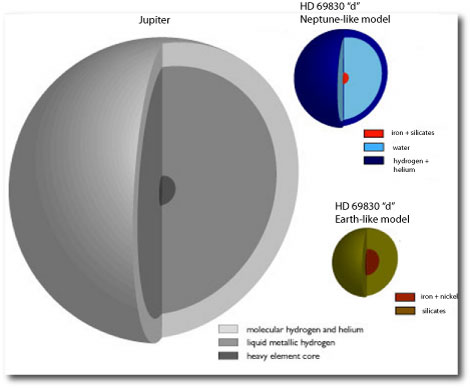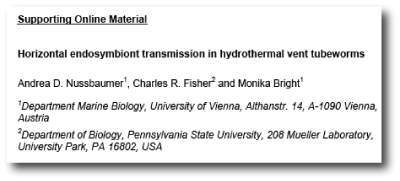
Source: Nicolle Rager Fuller NSF
HD 69830. What a difference a year makes. Last June, HD 69830 languished in the obscure backwaters of the Henry Draper Catalog. Now, however, like its buddy HD 209458, the star is a star. Google “HD 69830”, and the search returns 660 entries (and growing daily). Google “HD 69831” and (until the crawlers manage to find this post) your search does not match any documents.
In Thursday’s post, we gave an overview of the HD 69830 planetary system, which contains Neptune-mass planets in 8.67, 31.6, and 197 day orbits. Perhaps the most astonishing thing about this discovery announcement is the tiny radial velocity amplitude of the 197 day planet in the model. This object induces a radial velocity amplitude of 2.2 meters per second, with a reported error of only twenty centimeters per second. That’s about the speed your finger moves if you trace it quickly across the title of the discovery paper. This detection required a very quiet star and an extraordinary technique. The Swiss seem to have broken through to the next level.
I wonder what that outer planet looks like. Over at transitsearch.org, I have a Fortran cron job that processes all of the known exoplanets every night to produce updated transit ephemeris tables. In order to predict transit depths, the code needs an estimate for the planetary radius, which in turn requires an estimate of the effective surface temperature. The transitsearch model reports 262 K, just below the freezing point (273 K), suggesting a brilliantly reflective orb swathed in white water-based clouds.
In an upcoming post, I’ll delve into some responsible (and also some irresponsible) speculations about the world beneath those clouds. A responsible viewpoint has planet “d” forming at a larger orbital radius than it currently occupies, and then migrating in to position. In this formation-followed-by-migration scenario, there were plenty of ices available during planetary assembly, and the planet will have a structure (and size) very close to those of Neptune.

An irresponsible, more provocative scanario has planet d forming in-situ, out of refractory silicate and metallic materials. The final product in this case is a super Earth, smack in the sweet spot of the habitable zone, and endowed with ten Hubble times worth of geothermal activity. But more on that in the upcoming post.
A driving goal at oklo.org is to get our readers beneath the headlines and critically examining what the radial velocities themselves have to say. To do this, we need the data. The Lovis et al. discovery article in Nature contains a link to supplementary material, but when you click on the link you get a .pdf article about hydrothermal vent tubeworms:

Hmmm. Even if we adopt the most optimistic giant-Earth-like structural models for HD 69830 d, this supplementary material seems to be jumping the astrobiological gun. With tubeworms obscuring the radial velocities, we were compelled to resort to Dexter to extract as many velocities as we could from Figure 2 of the .pdf version of the paper. Eugenio managed to scrape 53 data points off the graph. We were busy using the console to work up fits to these dextered velocities when Darin Rogozzine at Caltech managed to guess the correct link and supplied oklo.org with the url.
In the next post, we’ll have a go at the rv’s. If you want an advance crack at them, they’re now on the web-based version of the console. We’ll get them on the downloadable version tomorrow.

Maybe the tubeworms are not that far fetched after all…
A. Leger et al. — A New Family of Planets ? “Ocean Planets” (http://arxiv.org/abs/astro-ph/0308324)
The idea of the article is that an extrasolar Neptune migrating into the habitable zone may become an “ocean planet”, a planet not an ice giant nor a real terrestrial covered with oceans tens of km deep over a mantle of ice thousands of km thick.
HD 69830 d could be a good a candidate for an ocean planet if it was not able to retain a thick hydrogen atmosphere. Unfortunately, the planet is probably too massive…
Hello all ! :-D
Actually, the spectrograph HARPS is the only one who can have a precision until 1 m/s ?
Also, I’m looking for a list of spectrographs used to search planets…?
-Sophie(northern hemisphere)
-HARPS(southern hemisphere)
-HIRES(northern hemisphere)
and ?
Hello Jyril, Vincent,
It’s actually a bit of a mystery why Neptune and Uranus managed to grab as much H/He as they have (a few Earth-masses worth). I can
readily imagine an environment, say in a cluster, where the residual hydrogen fraction during late stage planetesimal accretion is very low. That would pave the way for a Leger et al. style ocean planet.
I think that HARPS is indeed the only set-up that is mass producing RVs with 1 m/s precision. HIRES at Keck is also doing very well, but there have been no Keck-discovered planets announced with radial velocity amplitudes of ~2 m/s. Other spectrograph/telescope combinations that are producing precision RVs include the Hamilton Spectrograph (on the CAT and Shane telescopes at Lick) and spectrographs at HET, Magellan, and Subaru.
Hi everyone,
I wanted to add to Greg’s response that there are
also the ELODIE (northern hemisphere — I’m not sure if Sophie and ELODIE are the same spectrograph) and CORALIE (I believe southern hemisphere) spectrographs, the spectrograph at the Anglo-Australian Telescope, and Harvard’s AFOE (Advanced Fiber-Optic Echelle) at the Whipple Observatory, near Tucson, Arizona.
Hi all,
I just checked, and Sophie and ELODIE are two different spectrographs.
Pingback: systemic - Time for work!
Eugenio said “Sophie and ELODIE are two different spectrographs.”.
In fact, SOPHIE will operate from September, 2006.
It will be the “sister” of HARPS for the northern hepisphere. :-D
http://www.obs-hp.fr/www/guide/sophie/sophie-info.html
http://www.obs-hp.fr/www/guide/sophie/integration.html
Pingback: systemic - stability analysis